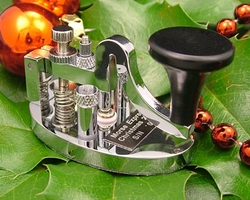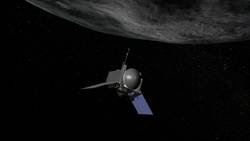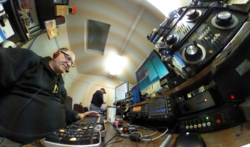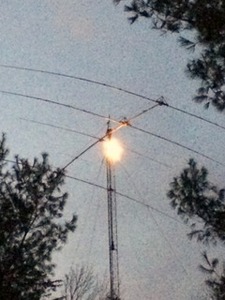 December 16, 2015 Editor: Paul Bourque, N1SFE | |||||
IN THIS ISSUE
NEW HF OPERATORS - THINGS TO DO
On December 19, there will be plenty of activity to enjoy in the Radio Amateurs of Canada RAC Winter Contest. All HF bands are included, as well as 6 and 2 meters. The thirteen multipliers (Canadian provinces + territories) count per band and per mode. There are also special point counts for special stations - usually they have the "RAC" suffix. Awards will be made to the top scorers in each category in each Canadian province/territory, US call district, and DXCC entity. Set aside a little time on December 20 to participate in the ARRL Rookie Roundup, CW. The contest is only six hours long, and you can work anyone if you've been licensed for less than three years. "Old Timers" are encouraged to invite rookies to use their stations. Rookies call "CQ RR" while non-rookies call "CQ R"; Rookies answer any CQ, non-rookies answer only "CQ RR." The weekend of December 26-27, you might try another 160 meter contest, the Stew Perry Top Band Distance Challenge. Read the rules about the distance-based scoring system, and how your power category affects your score. There are also a number of 'interesting' awards you might achieve. BUSTED QSOS N6MZ/ZF2MJ's score in the CQWW may have bested the previous North American record, not the WORLD record as I wrote in the last issue. Thanks to Chad, WE9V, for pointing this out. Complete information for all contests follows the Conversation section December 17 December 18 December 19 December 20 December 21 December 23 December 24 December 25 December 26 December 27 December 30
The next Klondike! US Citizens may now legally own asteroid material. A clear title and path to profit could open asteroids to mining. There is more coverage in Scientific American. DX Engineering has an online tool for ordering custom cables based on RG-231, RG-8X, RG-8U, 400MAX, RG-6 or copper ground braid cable types. A few clicks and some shipping time - voila, cables. Drones are becoming ever more powerful, and easier to control. They've already been used to put up wire antennas, inspect towers. Now multiple drones can be choreographed to build wire or rope structures, including this one that can support the weight of a human. (N0AX) Alex, VE3NEA was recently announced Radio Amateurs of Canada 2014 Radio Amateur of the Year. The award recognizes "outstanding and consistent contribution to the welfare of Amateur Radio" for his development of CW Skimmer. Congratulations Alex! Cellular data providers want to use Wi-Fi spectrum to provide LTE-U services, and leading tech companies say that Wi-Fi would suffer. Custom stainless steel parts from sheet have become easier to obtain. It appears that finished-good pricing can be competitive with raw sheet good prices. Wall Street is driving mergers in the chip industry . Calculations show that better financial numbers can be obtained by combining operations and "optimizing" provides greater yields than research and development of new products or technologies, due to increasing costs of R&D. A new form of carbon has been developed by researchers at NCSU by heating it to over 3700 degrees C and controlling the cooling. Besides the amorphous nature of the material, researchers report that it is ferromagnetic, conductive, and glows when exposed to low levels of energy . It may also be a precursor to the production of artificial diamonds. Now that we have some new tools for quantum computing, there's a race to use them to solve real-world problems in a particular area called annealing (more on annealing). Quantum computers are different in their theory and architecture, and require a re-thinking of how to "pose the problem." (N6KI) N3FJP's log scoring programs have had the ability to post score updates to a web page - Now he's added Club Score Processor 1.0, with the ability to scrape those score pages, aggregate them, and re-post a summary of that information for use by groups or clubs. The Yankee Clipper Contest Club (YCCC) has announced a matching program for donations to WRTC2018. "The matching gift will automatically be applied when individuals donate through WWROF (Paypal WRTC2018@wwrof.org) for WRTC 2018" according to Michael, DL6MHW. YCCC has allocated $1000 USD to this program which continues until February 28, 2016. Santa is very busy this time of year. That fat old elf is multi-oping, again, and can be contacted by turning your beams north (and a little east). Or just by tuning on 20 meters, or even 80 meters! If your holiday-spirit-infused guest operator is a little shy, perhaps they'd be less intimidated by NORAD's Santa Tracker. Fewer than 156 days to Dayton. WORD TO THE WISE - RST (Readability, Strength, Tone) In contesting use, the RST signal report is more of a placeholder, or merely an indicator that something important that should be logged is coming next. Though exchanged in most contests, it is nearly universally disregarded during the log scoring process. For CW contests, despite RST's numeric irrelevance for logging, the last number and two potential suffixes ARE important to pay attention to if you receive them. If you receive a "T" (third number) of anything other than "9", you should definitely check your signal. It could indicate that you have arcing in your tube final amplifier, or perhaps a power supply that is just on the edge of being able to supply your rig. Or perhaps your boat anchor's electrolytic capacitors require reformation or replacement. RST followed by "K" indicates that you are perceived to have key clicks on your signal. Perhaps your modern solid-state rig's keying waveform rise time is too sharp. Maybe you're hot switching an amplifier. On a crowded band, you are not going to be a popular person, as you're interfering with others on the band (and potentially outside of it). That's a lot of energy you could be putting into your carrier. RST followed by "C" indicates that your signal is perceived to have a chirp (carrier frequency instability). Something is causing your carrier frequency to shift during transmission. With modern radios, it's quite infrequent; during boat-anchor contests, or straight-key night when the tube radios come out to play, it's the sound of nostalgia. In a phone contest, you're usually going to get a 59 RS report, and direct comments regarding your signal if it's awful enough. Typical negative reports could include "Too much compression," "RF on your audio," or "lots of blower noise." Remember the old adage - only 1 in 73 contacts will actually tell you your signal is awful if it is.
Paul, NN6X took a spherical picture of the NX6T operation during the ARRL 10M contest last weekend. If your web browser supports it, it's fun to explore the shack by changing the perspective. Dennis, N6KI (black shirt), and Dave, N6EEG are pictured. N6MJ/ZF2MJ had a fantastic score in the recent CQWW CW contest by running two bands simultaneously. He described how he did this in his 3830scores post and you can see it for yourself on YouTube. The focus of this NY Times article is the potential disappearance of the Marshall Islands; the video scenery is spectacular. (W7WKR) Mast steps can be seen starting at about 4:31 in this ~1800 foot tower climbing video. See ham-relevant mast step information in the Technical Topics.
A couple of fun comments from the ARRL 10 Meter contest log submissions to 3830scores.com: "If 6 meters is the 'MAGIC' band, 10 meters is the 'MYSTERIOUS' band." (K3SEN) "First 13 somewhat difficult contacts were made from the mountain remote station using a dummy load instead of an antenna! ... I worked the East Coast and the Caribbean, so I knew the band was open but it just wasn't fun hearing so little and getting CQs in response to my calls. " (N6XI) Trend: More contest sponsors are accepting logs via web form submittal, which allows for immediate feedback for potential issues. Here's the message from submitting a log for WAE using the web site: "Thanks for participating in this years WAEDC RTTY! Changing the log submission from email to interactive upload reduced the number of bad logs tremendously. As a result we are able to present the raw scores just a few hours after the deadline!" Check those signals on 10m! "There were a number of fairly bad signals on 10 meters over the weekend, including splatter and chirp. A few stations were transmitting spurious signals many kHz away from the main signal, too. It is worth reminding the readers that 10 meters is at the upper range of most HF gear and therefore more susceptible to generating spurs or parasitics. If someone mentions that you have a poor signal, check the amp tuning or tuner settings to be sure you don't have something going wrong." (N0AX) Going that "last few feet" to the boom of the antenna can be easier if your mast has steps. A recent discussion on the Towertalk reflector focused on some of the options for these labor savers. (N0AX) It appears that more and more ham gear is shifting away from built-in RS-232 serial interfaces to embrace USB standards. My Icom 7410 conveniently has a single USB which handles the CAT interface as well as audio; my Elecraft K3 is upgradable to a built-in USB interface just like the newer K3S. The first USB specification was released in 1995, and achieved broad acceptance with v1.1 in 1998. Since then, USB 2.0 (2000) and USB 3.0 (2008) have brought significant improvements in speeds. USB-C provides an upgrade in functionality, complexity, and capability, but sacrifices direct hardware compatibility. The biggest anticipated consumer-benefit for USB-C is the potential to transfer up to 100 watts (!) of power between devices - the direction is negotiable by the devices. Something I'm looking forward to is USB-C's potential to consolidate the number of cables required to handle today's video, power, network, keyboard, mouse, serial, etc. especially for portable or 'dxpeditionary' use. Plugable.com already has some USB-C capable docking stations. For figuring out which coax is which in a large bundle (or for bundled and jumbled conductors in general), add a telephone tone generator to your bag of tools. -- Ward, N0AX Some could joke that a faraday cage for light is called a lampshade. Jokes aside, researchers have built a nanowire structure which blocks light, yet allows liquids and gasses to pass . The structures can be tuned to stop up to a 600nm range of wavelengths, or tuned to block two frequencies while allowing others to pass. If you enjoy the feel and clack-clack-clack noise of a mechanical switch computer keyboard, you might find the ability to construct your own appealing. (John Haskin) For a really retro experience, use a real vintage typewriter for your keyboard needs. (K3HX) Season of Wonder The holiday season can evoke strong feelings if not specific recollections of having been a child. The "magical" feelings of anticipation of a big day, the surprise of an outcome, the joy of a favor or kindness. As adults, life experience and reality can temper the magic; we have fewer mysteries, and fewer surprises. As adults we create those childhood experiences for those who are close to us, and those who are in need. As contesters, we can make tens, hundreds, or thousands of contacts. It's easy to just log another and move on, and we do. My holiday wish to you is that you find the time to turn on the radio, call CQ, and recapture your own sense of child-like anticipation and surprise, whether the answering station is an all-time new one, or an old friend. 73 & Happy Holidays, Brian N9ADG 17 Dec - 30 Dec 2015 An expanded, downloadable version of QST's Contest Corral in PDF format is available. Check the sponsor's Web site for information on operating time restrictions and other instructions. HF CONTESTS CWops Mini-CWT Test , Dec 16, 1300z to Dec 16, 1400z, Dec 16, 1900z to Dec 16, 2000z, Dec 17, 0300z to Dec 17, 0400z; CW; Bands: 160, 80, 40, 20, 15, 10m; Member: Name + Member No., non-Member: Name + (state/province/country); Logs due: December 19. 17 Dec - 30 Dec 2015 December 17, 2015 December 18, 2015 December 19, 2015 December 20, 2015 December 21, 2015 December 22, 2015 December 23, 2015 December 26, 2015 December 27, 2015 ARRL Information Click here to advertise in this newsletter, space subject to availability. Your One-Stop Resource for Amateur Radio News and Information ARRL membership includes QST, Amateur Radio's most popular and informative journal, delivered to your mailbox each month. Subscribe to NCJ - the National Contest Journal. Published bimonthly, features articles by top contesters, letters, hints, statistics, scores, NA Sprint and QSO Parties. Subscribe to QEX - A Forum for Communications Experimenters. Published bimonthly, features technical articles, construction projects, columns and other items of interest to radio amateurs and communications professionals. Free of charge to ARRL members: Subscribe to The ARRL Letter (weekly digest of news and information), the ARES E-Letter (monthly public service and emergency communications news), Division and Section news -- and much more! ARRL offers a wide array of products to enhance your enjoyment of Amateur Radio. Visit the site often for new publications, specials and sales. Donate to the fund of your choice -- support programs not funded by member dues! Reprint permission can be obtained by sending email to permission@arrl.org with a description of the material and the reprint publication. ACKNOWLEDGEMENTS ARRL Contest Update wishes to acknowledge information from WA7BNM's Contest Calendar and SM3CER's Contest Calendar. | |||||










